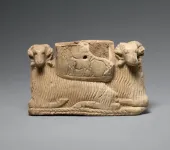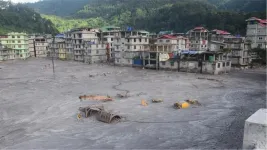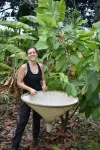(Press-News.org) In a comprehensive analysis, researchers present the divers, causes, and impacts of the catastrophic 2023 Sikkim glacial lake outburst flood (GLOF). The findings stress the urgent need to enhance GLOF hazard assessments and improve prediction and early warning systems as melting glaciers steadily raise the risk of GLOFs in the Himalayan region. South Lhonak Lake – perched at 5200 meters above sea level in the Upper Teesta basin of Sikkim, India – is among the region's largest and most rapidly expanding glacial lakes, posing severe hazards due to its potential for GLOFs. These hazards were realized on October 3, 2023, when the glacial lake experienced a catastrophic outburst, unleashing a flood cascade that claimed 55 lives, left 74 missing, and caused widespread downstream devastation, including the destruction of the Teesta-III hydropower dam. Combining high-resolution satellite imagery, seismic and meteorological data, field observations, and numerical modeling, Ashim Sattar and colleagues present a comprehensive and multidisciplinary analysis of the event. According to the findings, the outburst was triggered when a landslide containing 14.7 million cubic meters (m3) of frozen sediment collapsed into the lake, generating a ~20-meter tsunami-like wave that breached and eroded the frontal moraine containing the waterbody, releasing roughly half of the lake’s volume (~50 million m3 of water) and ~270 million m3 of sediment into the Teesta River valley. Moreover, Sikkim et al. show that climate warming intensified the event, as heavy rainfall primed the landscape for landslides that compounded sediment transport and downstream destruction in the Teesta Valley, which impacted Sikkim, West Bengal, and Bangladesh and damaged infrastructure as far as 385 kilometers away from the flood’s origin. According to the authors, the findings underscore the inadequacy of current GLOF models, which often fail to account for erosion, sediment transport, and cascading processes, and highlight the need for enhanced early warning systems, policy reforms, and adaptive risk management strategies, particularly in remote, high-altitude, vulnerable glacial regions like the Himalayas.
END
Drivers, causes and impacts of the 2023 Sikkim flood in India
Summary author: Walter Beckwith
2025-01-30
ELSE PRESS RELEASES FROM THIS DATE:
Most engineered human cells created for studying disease
2025-01-30
The most complex engineering of human cell lines ever has been achieved by scientists, revealing that our genomes are more resilient to significant structural changes than was previously thought.
Researchers from the Wellcome Sanger Institute, Imperial College London, Harvard University in the US and their collaborators used CRISPR prime editing to create multiple versions of human genomes in cell lines, each with different structural changes. Using genome sequencing, they were able to analyse the genetic effects of these structural variations on cell survival.
The research, published today (30 January) in Science, ...
Polar bear population decline the direct result of extended ‘energy deficit’ due to lack of food
2025-01-30
U of T Scarborough researchers have directly linked population decline in polar bears living in Western Hudson Bay to shrinking sea ice caused by climate change.
The researchers developed a model that finds population decline is the result of the bears not getting enough energy, and that’s due to a lack of food caused by shorter hunting seasons on dwindling sea ice.
“A loss of sea ice means bears spend less time hunting seals and more time fasting on land,” says Louise Archer, a U of T Scarborough postdoc and lead author of the study.
“This negatively affects the bears’ energy ...
Lifecycle Journal launches: A new vision for scholarly publishing
2025-01-30
(Charlottesville, VA, Jan. 30, 2025) – The Center for Open Science (COS) is excited to announce that Lifecycle Journal, a 3-year research and development pilot on a new model of scholarly communication, is now open for submissions. Lifecycle Journal reimagines scholarly publishing in line with scholarly values of rigor, transparency, sharing, correction, and community evaluation. Lifecycle Journal offers a dynamic, community-driven approach to scholarly publishing, providing a new experience for authors, reviewers, and readers to critically engage with research throughout the entire research lifecycle.
The traditional ...
Ancient DNA analyses bring to life the 11,000-year intertwined genomic history of sheep and humans
2025-01-30
Sheep have been intertwined with human livelihoods for over 11,000 years. As well as meat, their domestication led to humans being nourished by their protein-rich milk and clothed by warm, water-resistant fabrics made from their wool.
Now, an international and interdisciplinary team of researchers led by geneticists from Trinity College Dublin and zooarchaeologists from LMU Munich and the Bavarian State Collections of Natural History (SNSB) has deciphered the prehistoric cultural trajectory of this species by analysing 118 genomes recovered from archaeological bones dating across 12 millennia and stretching from Mongolia to ...
Climate change increases risk of successive natural hazards in the Himalayas
2025-01-30
An international study has investigated the causes and impacts of the devastating flood disaster in the Himalayas in October 2023, which destroyed large areas along and surrounding the Teesta River in Sikkim, India. A research team from nine countries, including researchers from the University of Zurich (UZH), analyzed the complex drivers, causes and consequences of this flood cascade and reconstructed the exact time of its onset.
Massive damage caused by tsunami wave
On 3 October 2023, approximately 14.7 million cubic meters of frozen ...
From bowling balls to hip joints: Chemists create recyclable alternative to durable plastics
2025-01-30
ITHACA, N.Y. – Cornell University researchers have developed a recyclable alternative to a durable class of plastics used for items like car tires, replacement hip joints and bowling balls.
Known as thermosets, this type of plastic boasts a “crosslinked polymer” chemical structure that guarantees longevity but has also made these petrochemical-based materials – which comprise 15%-20% of all polymers produced – impossible to recycle.
“Currently, zero percent of the world’s thermoset materials are recycled – they’re either incinerated ...
Promoting cacao production without sacrificing biodiversity
2025-01-30
The productivity of cacao trees decreases with time, forcing farmers to renew their plantations by either cutting down the old trees or establishing a new crop elsewhere. Frequently, new plantations are established in areas of the forest that are thinned out to accommodate new, young cacao trees. However, this comes with high economic and ecological costs. An alternative approach is to graft highly productive and native cultivars onto the existing older cacao trees. An international team led by scientists of the University of Göttingen found that cacao grafting is a useful measure to rejuvenate cacao plants, increasing their yield and profits with minimal impact on biodiversity. The ...
New £2 million project to save UK from food shortages
2025-01-30
Anglia Ruskin University (ARU) is leading a new £2 million initiative to help prevent food shortages that could potentially trigger civil unrest in the UK.
The project, called Backcasting to Increase Food System Resilience in the UK, is being led by experts from Anglia Ruskin’s Global Sustainability Institute and has received £2,048,461 in funding from the Biotechnology and Biological Sciences Research Council, part of UK Research and Innovation (UKRI).
Building on recent research that found that over 40% of food experts believe widespread civil unrest linked to food shortages, such as demonstrations and violent looting, is possible or likely in the UK within the next 10 ...
SCAI mourns Frank J. Hildner, MD, FSCAI: A founder and leader
2025-01-30
The Society for Cardiovascular Angiography and Interventions (SCAI) and the interventional cardiology community mourn the passing of Frank J. Hildner, MD, FSCAI, a founding member and past president (1989-90) of SCAI.
“Dr. Frank Hildner laid the foundation for SCAI’s growth and success. His visionary leadership helped guide SCAI through its formative years, ensuring it would become the trusted home for interventional cardiology. We are deeply grateful for his contributions and will continue to honor his legacy,” said SCAI President James B. Hermiller, MD, MSCAI.
Recognizing the need for a dedicated platform for interventional cardiologists, Dr. ...
New diagnostic tool will help LIGO hunt gravitational waves
2025-01-30
RIVERSIDE, Calif. -- Finding patterns and reducing noise in large, complex datasets generated by the gravitational wave-detecting LIGO facility just got easier, thanks to the work of scientists at the University of California, Riverside.
The UCR researchers presented a paper at a recent IEEE big-data workshop, demonstrating a new, unsupervised machine learning approach to find new patterns in the auxiliary channel data of the Laser Interferometer Gravitational-Wave Observatory, or LIGO. The ...
LAST 30 PRESS RELEASES:
University of Oklahoma researcher awarded funding to pursue AI-powered material design
Exploring how the visual system recovers following injury
Support for parents with infants at pediatric check-ups leads to better reading and math skills in elementary school
Kids’ behavioral health is a growing share of family health costs
Day & night: Cancer disrupts the brain’s natural rhythm
COVID-19 vaccination significantly reduces risk to pregnant women and baby
The role of vaccination in maternal and perinatal outcomes associated with COVID-19 in pregnancy
Mayo Clinic smartwatch system helps parents shorten and defuse children's severe tantrums early
Behavioral health spending spikes to 40% of all children’s health expenditures, nearly doubling in a decade
Digital cognitive behavioral treatment for generalized anxiety disorder
Expenditures for pediatric behavioral health care over time and estimated family financial burden
Air conditioning in nursing homes and mortality during extreme heat
The Alps to lose a record number of glaciers in the next decade
What makes a good proton conductor?
New science reporting guide published for journalists in Bulgaria
New international study reveals major survival gaps among children with cancer
New science reporting guide published for journalists in Turkey
Scientists develop a smarter mRNA therapy that knows which cells to target
Neuroanatomy-informed brain–machine hybrid intelligence for robust acoustic target detection
Eight SwRI hydrogen projects funded by ENERGYWERX
The Lundquist Institute and its start-up company Vitalex Biosciences Announces Strategic Advancement of Second-Generation fungal Vaccine VXV-01 through Phase 1 Trials under $40 Million Competitive Con
Fine particles in pollution are associated with early signs of autoimmune disease
Review article | Towards a Global Ground-Based Earth Observatory (GGBEO): Leveraging existing systems and networks
Penn and UMich create world’s smallest programmable, autonomous robots
Cleveland researchers launch first major study to address ‘hidden performance killer’ in athletes
To connect across politics, try saying what you oppose
Modulating key interaction prevents virus from entering cells
Project explores barriers to NHS career progression facing international medical graduates
Jeonbuk National University researchers explore the impact of different seasonings on the flavor perception of Doenjang soup
Two Keck Medicine of USC Hospitals named Leapfrog Top Teaching Hospitals
[Press-News.org] Drivers, causes and impacts of the 2023 Sikkim flood in IndiaSummary author: Walter Beckwith





